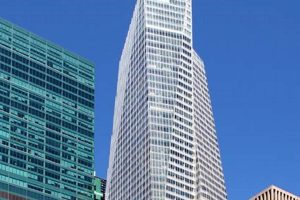Skyscrapers are defined as buildings with over 40 floors and a height of at least 150 meters. As a result, “Skyscraper Day” is an unofficial holiday dedicated to celebrating these architectural marvels.
Skyscrapers have played a significant role in shaping skylines, accommodating large populations, and serving as symbols of economic power. They provide numerous benefits, including efficient land utilization, improved energy efficiency, and enhanced accessibility to transportation hubs. Understanding the history and impact of skyscrapers allows us to appreciate the engineering feats and architectural achievements behind these iconic structures.
The main article will delve deeper into the historical evolution of skyscrapers, their architectural styles, and the engineering challenges involved in their construction. It will also explore the impact of skyscrapers on urban planning, sustainability, and the overall development of cities. Through this exploration, we aim to foster a greater appreciation for the ingenuity and innovation that have shaped these architectural wonders.
1. Height
Skyscrapers are celebrated on “Skyscraper Day” for their remarkable height, which has become a defining characteristic of these architectural wonders. Towering over the surrounding landscape, skyscrapers reshape skylines and become iconic landmarks.
- Engineering Marvels
The height of skyscrapers is a testament to the ingenuity and engineering prowess of architects and engineers. Constructing structures that soar thousands of feet into the sky requires innovative solutions to ensure structural stability and withstand various forces, including wind, earthquakes, and gravity. - Vertical Communities
Skyscrapers enable the creation of vertical communities, accommodating large populations within a limited footprint. This efficient use of space is crucial in dense urban areas, allowing for the development of mixed-use buildings that combine residential, commercial, and retail spaces. - Urban Icons
The height of skyscrapers makes them instantly recognizable landmarks, shaping the identity of cities and becoming symbols of economic power and progress. From the Empire State Building in New York City to the Burj Khalifa in Dubai, these towering structures have become synonymous with the cities they inhabit. - Architectural Innovation
The pursuit of height has driven architectural innovation, leading to the development of new materials, construction techniques, and design concepts. Skyscrapers showcase a range of architectural styles, from the Art Deco skyscrapers of the early 20th century to the sleek, modern designs of contemporary high-rises.
In conclusion, the height of skyscrapers is not merely a physical attribute but a testament to human ingenuity, engineering prowess, and architectural innovation. On “Skyscraper Day,” we celebrate these towering structures for their contributions to urban development, cultural identity, and the advancement of architectural design.
2. Engineering
The construction of skyscrapers is a complex undertaking that requires advanced engineering techniques to ensure the structural stability and integrity of these towering structures. This engineering prowess is a cornerstone of “Skyscraper Day,” as it enables the creation of these architectural marvels that reshape skylines and push the boundaries of human ingenuity.
- Innovative Structural Systems
Skyscrapers employ innovative structural systems, such as braced frames, shear walls, and moment-resisting frames, to distribute and withstand the immense forces acting upon them. These systems work together to ensure the stability of the building under various loads, including gravity, wind, and seismic activity. - High-Performance Materials
Skyscrapers utilize high-performance materials, such as reinforced concrete, structural steel, and composite materials, to achieve the necessary strength and durability. These materials allow for the construction of slender and lightweight structures that can withstand extreme conditions. - Wind Engineering
Wind engineering plays a crucial role in skyscraper design, as high-rise buildings are susceptible to wind forces. Engineers conduct wind tunnel tests and employ aerodynamic design features to minimize wind-induced vibrations and ensure the comfort and safety of occupants. - Seismic Design
In earthquake-prone regions, skyscrapers are designed to withstand seismic forces. This involves incorporating base isolation systems, energy dissipation devices, and special structural configurations to protect the building and its occupants from the damaging effects of earthquakes.
The engineering behind skyscrapers is a testament to human ingenuity and the pursuit of architectural excellence. On “Skyscraper Day,” we celebrate the engineers and architects who have pushed the boundaries of engineering to create these iconic structures that redefine our cities and inspire us to reach new heights.
3. Architecture
The architectural diversity of skyscrapers is a defining characteristic celebrated on “Skyscraper Day.” These towering structures serve as canvases for architects to express their creativity and push the boundaries of design.
Skyscrapers have evolved through various architectural styles, each reflecting the cultural and technological influences of their time. From the ornate Art Deco skyscrapers of the early 20th century to the sleek Modernist high-rises of the postwar era, each style has left an indelible mark on the skylines of cities worldwide.
The architectural styles of skyscrapers not only enhance their aesthetic appeal but also impact their functionality and structural integrity. For instance, the setbacks and decorative elements of Art Deco skyscrapers helped reduce wind resistance and provided additional structural support. In contrast, the minimalist designs of Modernist skyscrapers emphasized clean lines and the use of glass curtain walls, allowing for maximum natural light and panoramic views.
Understanding the architectural diversity of skyscrapers is essential for appreciating their cultural and historical significance. By recognizing the different styles and their respective contexts, we gain a deeper appreciation for the evolution of architecture and the role skyscrapers have played in shaping our built environment.
4. Urban Planning
The connection between urban planning and “Skyscraper Day” lies in the crucial role skyscrapers play in shaping urban environments. Skyscrapers are not merely isolated structures but integral components of city planning, contributing to efficient land use and accommodating growing populations in dense urban areas.
As cities expand and populations increase, urban planners face the challenge of accommodating more people while preserving green spaces and ensuring a high quality of life. Skyscrapers offer a solution by enabling vertical growth, allowing for increased density without sacrificing valuable land for urban sprawl. By building upwards, cities can optimize land use, preserving parks, green spaces, and other essential urban amenities.
Moreover, skyscrapers facilitate the creation of mixed-use developments, combining residential, commercial, retail, and cultural spaces within a single building. This integration promotes walkability, reduces reliance on cars, and fosters vibrant, self-contained communities. By incorporating sustainable design features, modern skyscrapers also contribute to reducing the environmental impact of urbanization.
Understanding the connection between urban planning and skyscrapers is essential for appreciating the role of these architectural marvels in shaping livable and sustainable cities. On “Skyscraper Day,” we celebrate the ingenuity of architects and urban planners who have harnessed the potential of skyscrapers to create thriving and dynamic urban environments.
5. Sustainability
The connection between sustainability and “Skyscraper Day” lies in the growing recognition of the environmental impact of buildings and the role that skyscrapers can play in mitigating it. Modern skyscrapers are increasingly incorporating sustainable design features that promote energy efficiency and reduce their environmental footprint.
Sustainable skyscrapers employ various strategies to reduce energy consumption, such as:
- Energy-efficient building envelope: The building envelope, including walls, windows, and roofs, is designed to minimize heat loss and gain, reducing the need for heating and cooling.
- Efficient lighting systems: LED lighting and daylighting techniques are used to reduce energy consumption for lighting.
- Renewable energy sources: Solar panels, wind turbines, and geothermal energy can be integrated into skyscrapers to generate clean energy.
- Water conservation measures: Low-flow fixtures, rainwater harvesting systems, and greywater reuse can reduce water usage.
Incorporating sustainable design features not only reduces the environmental impact of skyscrapers but also provides economic benefits. Energy-efficient buildings have lower operating costs, increased occupant comfort, and enhanced property value. As a result, sustainable skyscrapers are becoming increasingly common and are recognized as a key component of green and sustainable cities.
By understanding the connection between sustainability and “Skyscraper Day,” we appreciate the importance of incorporating sustainable practices into the design and construction of skyscrapers. Sustainable skyscrapers contribute to a more sustainable built environment and demonstrate the commitment of architects and developers to reducing the environmental impact of their projects.
6. Economic Impact
On “Skyscraper Day,” we recognize the significant economic impact of skyscrapers, which have become symbols of economic power and drivers of urban growth and development. The construction of skyscrapers often coincides with periods of economic prosperity and reflects a city’s ambition and optimism.
Skyscrapers have a multiplier effect on the economy. Their construction creates jobs in various sectors, including architecture, engineering, construction, and real estate. Additionally, skyscrapers attract businesses and investment, leading to increased economic activity in the surrounding area. The presence of iconic skyscrapers can also boost tourism and enhance a city’s global image.
For example, the construction of the Empire State Building in New York City during the Great Depression not only created jobs but also symbolized hope and economic recovery. Similarly, the Petronas Towers in Kuala Lumpur and the Burj Khalifa in Dubai have become iconic landmarks that have spurred economic growth and development in their respective cities.
Understanding the economic impact of skyscrapers is essential for appreciating their role in shaping urban landscapes and economies. Skyscrapers are not just architectural marvels; they are also economic powerhouses that contribute to the prosperity and vitality of cities.
7. Cultural Significance
The cultural significance of skyscrapers is deeply intertwined with “Skyscraper Day,” as these architectural wonders have become iconic landmarks that shape city skylines and serve as symbols of cultural identity and achievement.
- Symbols of Urban Identity
Skyscrapers have become synonymous with the cities they inhabit, often serving as recognizable symbols on a global scale. The Empire State Building is synonymous with New York City, the Petronas Towers with Kuala Lumpur, and the Burj Khalifa with Dubai. These skyscrapers embody the spirit and ambition of their respective cities, becoming cultural icons that evoke a sense of pride and belonging. - Architectural Masterpieces
Skyscrapers are architectural marvels that push the boundaries of design and engineering. Their innovative forms and soaring heights have captured the imagination of people worldwide. The Chrysler Building in New York City, with its Art Deco design, and the Shard in London, with its unique glass facade, are just two examples of the architectural masterpieces that have become cultural landmarks. - Cultural Expression
Skyscrapers often reflect the cultural values and aspirations of the societies that build them. For example, the traditional Chinese influence in the design of the Bank of China Tower in Hong Kong reflects the city’s cultural heritage. Similarly, the One World Trade Center in New York City symbolizes resilience and hope after the tragic events of 9/11. - Tourism and Recreation
Skyscrapers have become major tourist attractions, offering breathtaking views and unique experiences. Observation decks, such as the Top of the Rock in New York City and the Skydeck in Chicago, provide visitors with panoramic vistas of the surrounding urban landscape. Additionally, skyscrapers often house restaurants, bars, and other amenities that cater to locals and tourists alike.
In conclusion, the cultural significance of skyscrapers is undeniable. They are symbols of urban identity, architectural masterpieces, expressions of cultural values, and popular tourist destinations. On “Skyscraper Day,” we celebrate the cultural impact of these iconic structures and recognize their role in shaping our cities and our collective imagination.
Skyscraper Day FAQs
To enhance our understanding
of “Skyscraper Day,” let’s delve into some frequently asked questions that address common concerns and misconceptions surrounding these architectural marvels:
Question 1: What exactly is “Skyscraper Day”?
Answer: “Skyscraper Day” is an unofficial holiday dedicated to celebrating skyscrapers, architectural wonders that have reshaped skylines and left an indelible mark on the urban landscape.
Question 2: Why is it important to have a day dedicated to skyscrapers?
Answer: “Skyscraper Day” serves as an opportunity to recognize the engineering ingenuity, architectural prowess, and cultural significance of skyscrapers. It fosters an appreciation for these iconic structures and highlights their contributions to urban development and global identity.
Question 3: What are the defining characteristics of a skyscraper?
Answer: Skyscrapers are generally defined as buildings that exceed 40 floors and stand at least 150 meters tall. Their height, coupled with innovative structural systems, allows for efficient land use and the creation of vertical communities.
Question 4: How do skyscrapers impact urban planning and sustainability?
Answer: Skyscrapers play a crucial role in urban planning by optimizing land use and accommodating dense populations. Modern skyscrapers increasingly incorporate sustainable design features to minimize their environmental footprint and promote energy efficiency.
Question 5: What are some iconic skyscrapers that have shaped city skylines?
Answer: Notable skyscrapers include the Empire State Building in New York City, the Petronas Towers in Kuala Lumpur, and the Burj Khalifa in Dubai. These architectural marvels have become symbols of their respective cities and have left a lasting legacy on the global skyline.
Question 6: What does the future hold for skyscraper design and construction?
Answer: The future of skyscraper design is expected to focus on sustainability, innovation, and mixed-use developments. Architects and engineers are continuously exploring new materials, technologies, and design concepts to push the boundaries of skyscraper construction and create sustainable and livable urban environments.
In summary, “Skyscraper Day” serves as a reminder of the remarkable achievements in architecture and engineering that skyscrapers represent. These iconic structures have transformed cities, influenced cultural identities, and continue to inspire innovation in urban design.
The exploration of skyscrapers and their multifaceted impact provides valuable insights into the evolution of our built environment and the ongoing pursuit of architectural excellence.
Skyscraper Day Tips
In celebration of “Skyscraper Day,” let’s delve into practical tips that can enhance our appreciation and understanding of these architectural marvels:
Tip 1: Guided Tours
Take advantage of guided tours offered by many skyscrapers, providing an insider’s perspective on their design, construction, and historical significance.
Tip 2: Observation Decks
Ascend to observation decks to experience breathtaking panoramic views of the city and surrounding landscapes. These vantage points offer a unique perspective on the scale and grandeur of skyscrapers.
Tip 3: Architectural Appreciation
Study the architectural details of skyscrapers, from their facades to their structural elements. Observe how different styles, such as Art Deco or Modernist, have shaped the appearance of these buildings.
Tip 4: Historical Context
Research the history behind skyscrapers, understanding the technological advancements and societal factors that have influenced their development over time.
Tip 5: Engineering Marvels
Appreciate the engineering feats that make skyscrapers possible. Learn about the innovative structural systems, wind-resistant designs, and sustainable features that ensure their safety and stability.
Tip 6: Urban Impact
Consider the impact of skyscrapers on urban planning and development. Examine how they contribute to efficient land use, vertical communities, and the overall transformation of city skylines.
Tip 7: Cultural Significance
Recognize the cultural significance of skyscrapers as symbols of economic power, national pride, and architectural achievement.
Tip 8: Future Innovations
Stay informed about the latest trends in skyscraper design and construction. Explore how architects and engineers are pushing the boundaries of innovation to create sustainable and resilient high-rise structures.
These tips will help cultivate a deeper appreciation for skyscrapers, enabling us to recognize their architectural brilliance, engineering prowess, and cultural impact.
As we celebrate “Skyscraper Day,” let us continue to marvel at these towering testaments to human ingenuity and strive to understand and preserve their legacy for future generations.
Skyscraper Day
“Skyscraper Day” serves as a testament to the remarkable achievements in architecture and engineering that have shaped our skylines and transformed our cities. These iconic structures embody the pursuit of innovation, sustainability, and cultural expression.
Through their towering heights, skyscrapers have reshaped urban planning, allowing for efficient land use and the creation of vertical communities. Their sustainable designs and energy-efficient features contribute to a more environmentally conscious built environment. As symbols of economic power and urban identity, skyscrapers have become cultural landmarks that reflect the aspirations and values of the societies that build them.
As we celebrate “Skyscraper Day,” let us continue to appreciate the architectural brilliance, engineering prowess, and cultural significance of these iconic structures. By understanding their history, impact, and ongoing evolution, we can foster a deeper connection to our built environment and inspire future generations of architects and engineers to push the boundaries of innovation and create sustainable and livable cities.







